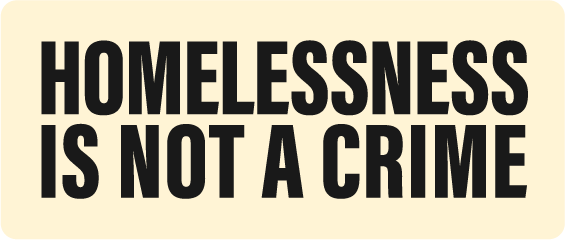
RESPOND TO ENCAMPMENTS WITH PROVEN SOLUTIONS
Encampments and unsheltered homelessness are daily reminders of the affordable housing crisis in our country.
But criminalizing homelessness by enforcing laws that make it illegal to sleep outside, even when there are no alternatives, isn’t the answer.
Visit Housing Not Handcuffs for more on tracking the criminalization of homelessness.
HOMELESSNESS IS NOT A CRIME
Criminalization extends homelessness.
Unpaid fines can result in a person being disqualified from public housing, and the impact on the person’s credit report can make it more difficult to rent a market-rate apartment.
Criminalization severs connections to service providers.
Vigorous enforcement of anti-camping laws can push people who are experiencing homelessness into more remote areas, thereby disrupting vital connections street medicine teams and increasing the risk of overdose and death.
Criminalization does not reduce homelessness.
Without a pathway to permanent housing and social services, orders to move along or face unpayable fines simply result in people who are homeless moving from block to block.
Criminalization is expensive.
The criminalization of homelessness diverts police resources away from more serious crimes and creates a homelessness to jail cycle that is expensive for taxpayers.
Alternatives to criminalization are more effective.
Alternatives to criminalization including permanent supportive housing (PSH), housing first, and rapid re-rehousing (RRH) are proven, cost-effective, methods to end and prevent homelessness.
TOGETHER WE MUST
TOGETHER WE MUST
Conduct Housing-Focused Outreach
Develop a by-name list of encampment residents. Record the housing, healthcare and service needs of each person. Include previous successes and barriers. Deploy mobile assessors and outreach workers to connect encampment residents directly to housing.
Create Pathways to Permanent Housing
Avoid costly, wasteful and counterproductive encampment sweeps by creating viable pathways to permanent housing for every encampment resident prior to an encampment closure.
Earmark beds for encampment closures
Resolve documentation needs
Suspend encampment closures when beds are unavailable
Communicate Effectively
Minimize the spread of misinformation and disruptions in clinical care by engaging early and often with key stakeholders, including encampment residents, outreach workers, healthcare providers, housed neighbors, businesses and advocates.
Ensure that stakeholders are aware of key elements of the plan (i.e. the number of unique individuals who have been engaged, plans for housing treatment and follow-up).
Protect Civil Rights
Protect the civil rights of encampment residents by providing notice and storage for personal belongings when encampments are cleared.
Partner with an Independent Monitor
Ensure compliance with all laws and policies governing encampment resolutions by partnering with an independent monitor or watchdog.


